monthly magazine Whitewater Rafting in Maine BY Vanessa Lemanski The state of Maine is home to the best whitewater rafting in New England. The area offers various rafting experiences suitable for all ages and skill levels. Whitewater rafting refers to a group of people paddling on a single raft down a river through rapids and challenging obstacles. Whitewater is formed when a fastflowing river is altered by a steep gradient, obstacles such as rocks, or contrictions to the flow. These scenarios cause the water to get bubbly and frothed and appear white. Whitewater is differentiated by classes, which explain how dangerous the area is. The classes are numbered 1-6, with 1 being very easy and 6 being practically impossible to pass. Rafting season in Maine typically starts in late April/early May and lasts through early October, and the rapids are most active in the spring due to the snow melt. In the summer there are scheduled dam releases to guarantee action. In the fall, there are less rapids and less people, making it a great time to raft with children. There are three main rivers that are rafted in this state: the Kennebec River, the Penobscot River, and the Dead River. Each offer a very different experience. The Kennebec River is most common among beginners. This river has a little bit of everything. The upper area has more rapids and waves, while the lower section offers easy, family-friendly fun. There are controlled dam releases throughout the spring and summer so it is consistent and there aren’t any surprises. The rapids below the dam are rated classes 3-4, so they are exciting, and further down the river they drop to class 2 and class 1, which is much more leisurely. This river has everything you need for a family rafting adventure. The Penobscot River is most notable for its challenging rapids and is popular with rafting enthusiasts. The rapids are classes 4-5, and feature exhilarating waterfall drops. There are scheduled dam releases in the Penobscot to keep the fun going all summer long. This river runs by the base of Mount Katahdin, the tallest mountain in Maine, providing unbeatable views with the excitement. The Dead River is a sought-after rafting experience in the state of Maine. The rapids are classes 3-4, but require more technical maneuvers and knowledge, so it is more of an advanced rafting adventure. This river is home to the longest continuous stretch of whitewater in Maine. There aren’t scheduled dam releases in the Dead River as often as the other big rafting rivers, only a few times a year. Rafters vie for the opportunity to raft those dates and enjoy the 16 miles of premium rapids this river offers. Especially for beginners, it is best to go rafting with a reliable tour guide company. The rafting tour guides know where the rapids are, and how to maneuver them safely. Some popular companies in the area include Northeast Whitewater in the Moosehead Lake area, Three Rivers Whitewater in the West Forks, and North Country Rivers in Bingham. Each company offers trips through the three big rivers, but each are unique, almost allowing you to customize the rafting trip you want to experience. There is everything from simple day trips to multiple-day experiences with other activities in between rafting. When planning your rafting trip, it is important to bring the right supplies. You will need a swimsuit, sunscreen, shoes with ankle straps, tethered sunglasses if you are bringing them, and overclothes made of moisture-wicking fabric. Most companies do not recommend that you wear anything made of cotton, as it pulls the heat from your body. You should also bring a towel and change of clothes for after the journey. No matter the rafting experience you decide to embark on, you are bound to enjoy Maine’s beauty and excitement. Happy rafting!
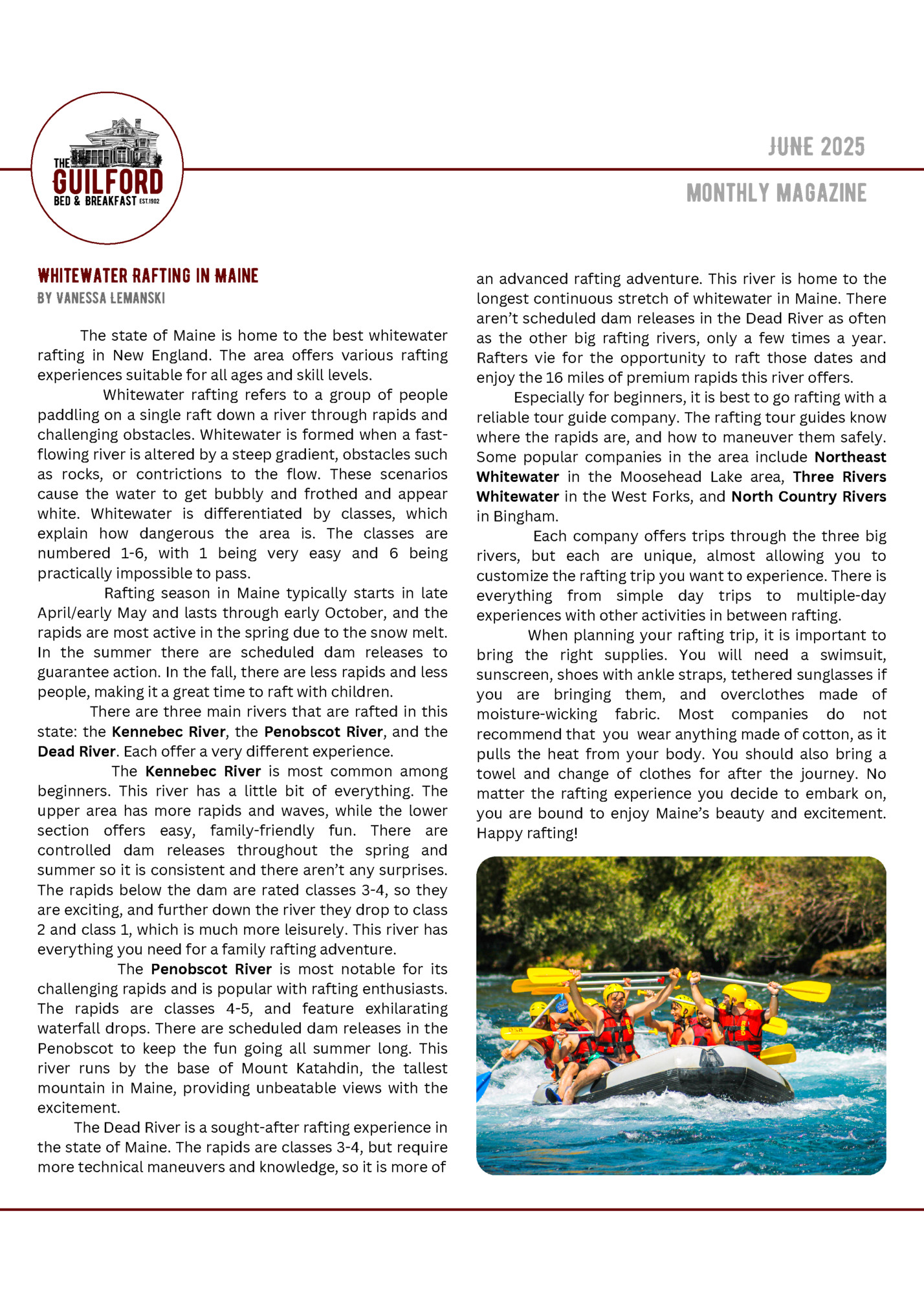
The Kennebec meets five other rivers to form Merrymeeting Bay 15 miles before it flows into the Atlantic Ocean. Merrymeeting Bay is a large inland tidal bay that is mostly freshwater, but contains a slight amount of salt, which makes it an unusual body of water. It is the third-largest freshwater tidal delta in North America, and is home to many endangered plant and animal species. It is also a breeding ground for anadromous fish in the Gulf of Maine. Because of the mixing of saltwater from the ocean, the Kennebec is tidal in lower areas of the river, so the river’s volume changes daily. The Kennebec River and its surrounding basin offer a truly unique experience, whether you are exploring the history of the area, enjoying the wildlife, or just looking for some fun! By Vanessa Lemanski The Kennebec River is a 170-mile-long river that runs through the state of Maine. It originates from Moosehead Lake and runs south to the Atlantic Ocean, emptying into the Gulf of Maine at Popham Beach. This river offers opportunities for leisure activities such as rafting, boating, and fishing, provides hydroelectric power, and has played a key role in Maine’s history. The name Kennebec comes from the Abenaki tribe and means “long quiet water,” which accurately describes the lower portion of the river. The river was explored by Samuel de Champlain between 1604 and 1605. The first English settlement in Maine was established along the Kennebec in 1607, near present-day Augusta, and the Kennebec River was used by Native American tribes and Europeans for fishing and transport by water, and its basin nourished essential forestry. By the 19th century, the river began to support commercial uses, and in the late 1800s, the northern Kennebec was a crucial source for ice harvesting. In the 1900s, the river provided power for and supported the needs of the logging industry and paper mills. These operations led to an immense amount of pollution in the river. After the federal Clean Water Act of 1972, the Kennebec quickly began to make improvements in the cleanliness of the water, and by 1986, it was deemed clean and usable for recreational activities. Today, the Kennebec is the perfect destination for all sorts of nature-fueled fun. You can kayak, boat, fish, and raft the river. The Kennebec River is a fantastic opportunity for whitewater rafting. The river is home to the Harris Dam Station, which is the largest hydroelectric dam in the state. This dam is opened often, and below is the Kennebec Gorge, a run of rapids, waves, excitement, and eventually a leisurely raft ride. The river is home to an array of fish species, including herring, bass, Atlantic and short-nosed sturgeon, and Atlantic Salmon. Because the Kennebec empties into the Atlantic, it provides the opportunity for migratory ocean fish to swim upstream, sometimes as far as Waterville. 2
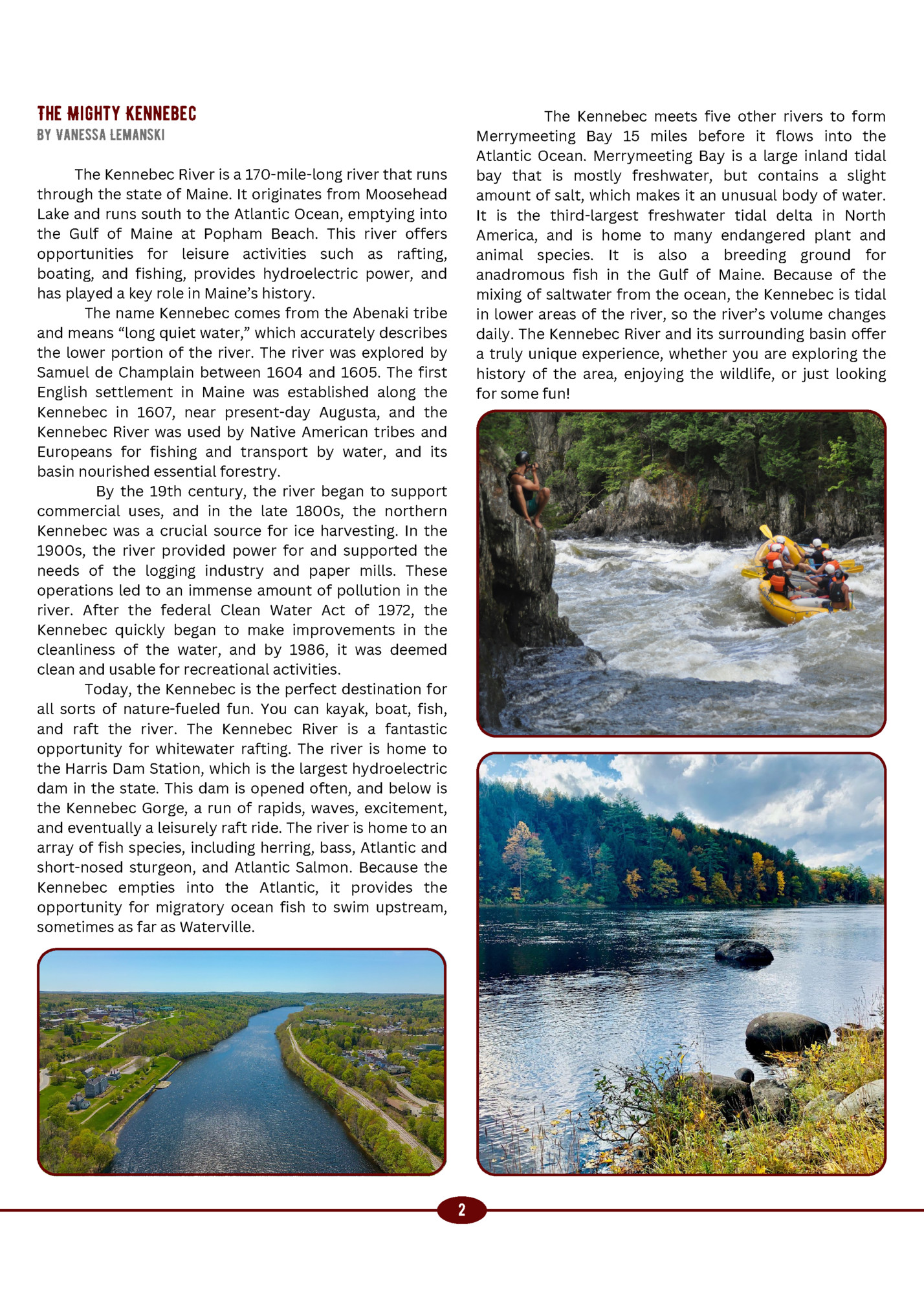
Cricket songs provide the soundtrack for warm nights, while fireflies blink their magical codes across meadows and backyards. These bioluminescent beetles create some of Maine's most enchanting natural displays, especially in late June and July. Next time you're exploring Maine's outdoors, take a moment to observe these incredible creatures. Whether it's watching a butterfly sip nectar from a lupine or listening to the evening chorus of katydids, Maine's insects offer endless opportunities for wonder and discovery. They're not just part of the scenery – they're essential threads in the intricate web of life that makes Maine's natural world so extraordinary. The Buzz of Maine's Spring & SUMMER Insects By John McNamara As winter's grip finally loosens across the Pine Tree State, Maine transforms into a vibrant ecosystem teeming with six-legged residents. From the first warm days of April through the golden afternoons of August, the state comes alive with an incredible diversity of insects that play essential roles in our natural world. When temperatures first climb above freezing, some of Maine's hardiest insects emerge from their winter hideouts. Mourning cloak butterflies, with their deep purple wings bordered in bright yellow, are often the first butterflies you'll spot dancing through the woods. These resilient beauties actually overwinter as adults, tucked away under loose bark or in tree crevices. Stone flies begin their brief adult lives along Maine's pristine streams and rivers, while tiny midges perform their mating dances in swirling clouds above warming waters. These early insects provide crucial food for hungry birds returning from their southern migrations. May brings an explosion of insect activity. Blackflies, though notorious for their persistent attention to hikers and gardeners, are actually vital pollinators and food sources for wildlife. While their bites can be annoying, these tiny flies support countless birds, bats, and spiders throughout the season. Spring azure butterflies flutter through woodland clearings with their delicate blue wings, while tent caterpillars begin constructing their silky homes in cherry and apple trees. Though sometimes considered pests, these caterpillars eventually transform into beautiful moths and serve as important food sources for numerous bird species. Summer in Maine showcases the state's most beloved insects. Monarch butterflies grace gardens with their orange and black majesty, stopping to fuel up on milkweed during their incredible migration journey. Luna moths, pale green and ethereal, emerge on warm nights, their long tails trailing behind them like ribbons in the moonlight. The woods fill with the industrious sounds of beetles going about their business of decomposing fallen logs and recycling nutrients back into the forest floor. Longhorn beetles, with their impressive antennae, and colorful flower beetles add splashes of metallic green and copper to summer wildflowers. Maine's native bees deserve special recognition for their tireless pollination services. While honeybees get much attention, the state hosts over 270 native bee species, from tiny sweat bees to robust bumblebees. These native pollinators are perfectly adapted to Maine's climate and plants, often visiting flowers before honeybees even venture out on cool mornings. 3
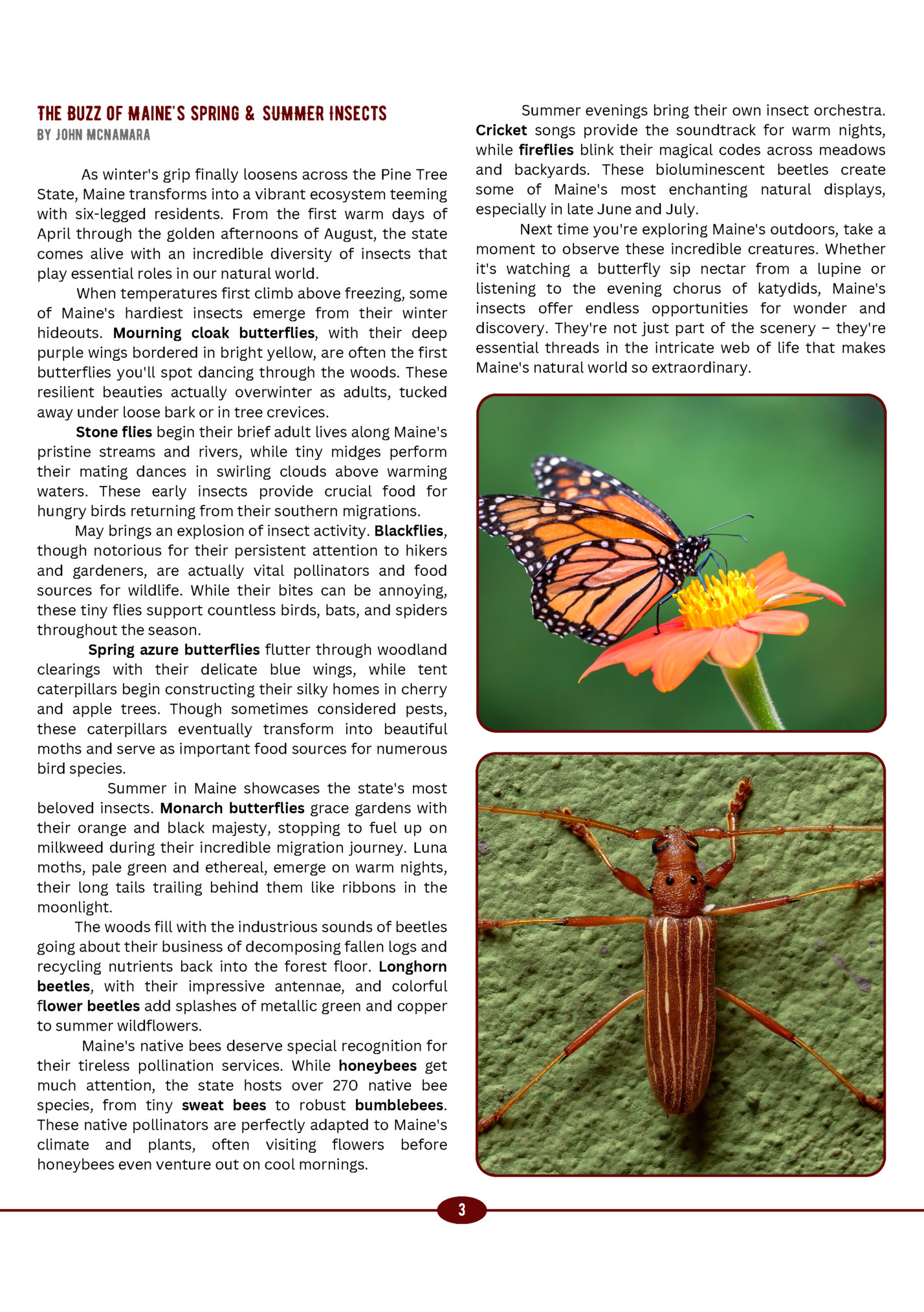
By John McNamara After months of snow and freezing temperatures, nothing signals the arrival of spring in Maine quite like the emergence of native wildflowers. These hardy perennials have adapted perfectly to the state's challenging climate, creating spectacular displays that reward patient observers with delicate beauty and vibrant colors. From the forest floor to sunny meadows, Maine's spring flowers offer a diverse and enchanting show that begins as early as March and continues well into June. Before the last snow has melted, some of Maine's most determined flowers begin their annual debut. Skunk cabbage, with its unusual purple-mottled spathe, actually generates its own heat to melt through snow and ice. This remarkable plant can raise its internal temperature up to 35 degrees above the surrounding air, making it one of nature's most impressive cold-weather performers. Soon after, bloodroot pushes through the leaf litter with pristine white petals surrounding a golden center. These ephemeral beauties last only a few days, but their brief appearance marks the true beginning of spring's floral parade. The plant gets its name from the orange-red sap in its roots, which Native Americans traditionally used for dye and medicinal purposes. Maine's forests come alive with spring ephemerals – flowers that bloom, reproduce, and go dormant before the tree canopy fully leafs out and blocks the sunlight. Trout lily, with its distinctive mottled leaves and nodding yellow blooms, carpets the forest floor in dappled patches of gold. These charming flowers can take up to seven years to mature from seed to first bloom, making each sighting special. Wild ginger hides its curious burgundy flowers beneath heart-shaped leaves, blooming close to the ground where they attract their ant pollinators. While the flowers might be easy to miss, the aromatic roots have been used for centuries as a spice and medicine. Perhaps most beloved of all is the painted trillium. These three-petaled beauties display white blooms with distinctive pink or red streaks at their base, rising elegantly above three large leaves. Finding a patch of trilliums in full bloom feels like discovering nature's secret treasure room. Maine's abundant wetlands host their own spectacular spring flower show. Wild iris, also called blue flag, stands tall in marshy areas with stunning purple-blue blooms that rival any cultivated garden variety. These native iris have provided food and fiber to indigenous peoples for generations. In boggy areas, pitcher plants produce unusual maroon flowers that dangle from tall stalks above their insect-catching leaves. While these carnivorous plants are more famous for their predatory habits, their spring blooms are equally fascinating and beautiful. As spring progresses into early summer, Maine's meadows burst with color. Wild lupine creates spectacular purple spikes that can stretch for acres, providing crucial habitat for the rare Karner blue butterfly. These nitrogen-fixing plants actually improve soil quality while creating breathtaking displays. Pink lady's slipper orchids emerge in acidic soils, their pouched blooms resembling tiny ballet slippers. These remarkable orchids depend on specific soil fungi to survive, making them indicators of healthy forest ecosystems. Many of Maine's native spring flowers face pressure from habitat loss and invasive species. When exploring these natural gardens, remember to observe without picking – many species take years to recover from harvesting, and some, like trilliums, may never return if their root systems are disturbed. The best way to enjoy Maine's spring flower show is through patient observation and photography. Each bloom represents millions of years of evolution and adaptation, creating perfect partnerships with local pollinators and wildlife. These flowers don't just mark the changing seasons – they're essential components of Maine's ecological web, supporting everything from tiny native bees to black bears emerging from winter dens. Take time this spring to discover these natural treasures. They're blooming right outside your door, waiting to share their quiet beauty with anyone willing to slow down and look closely. 4
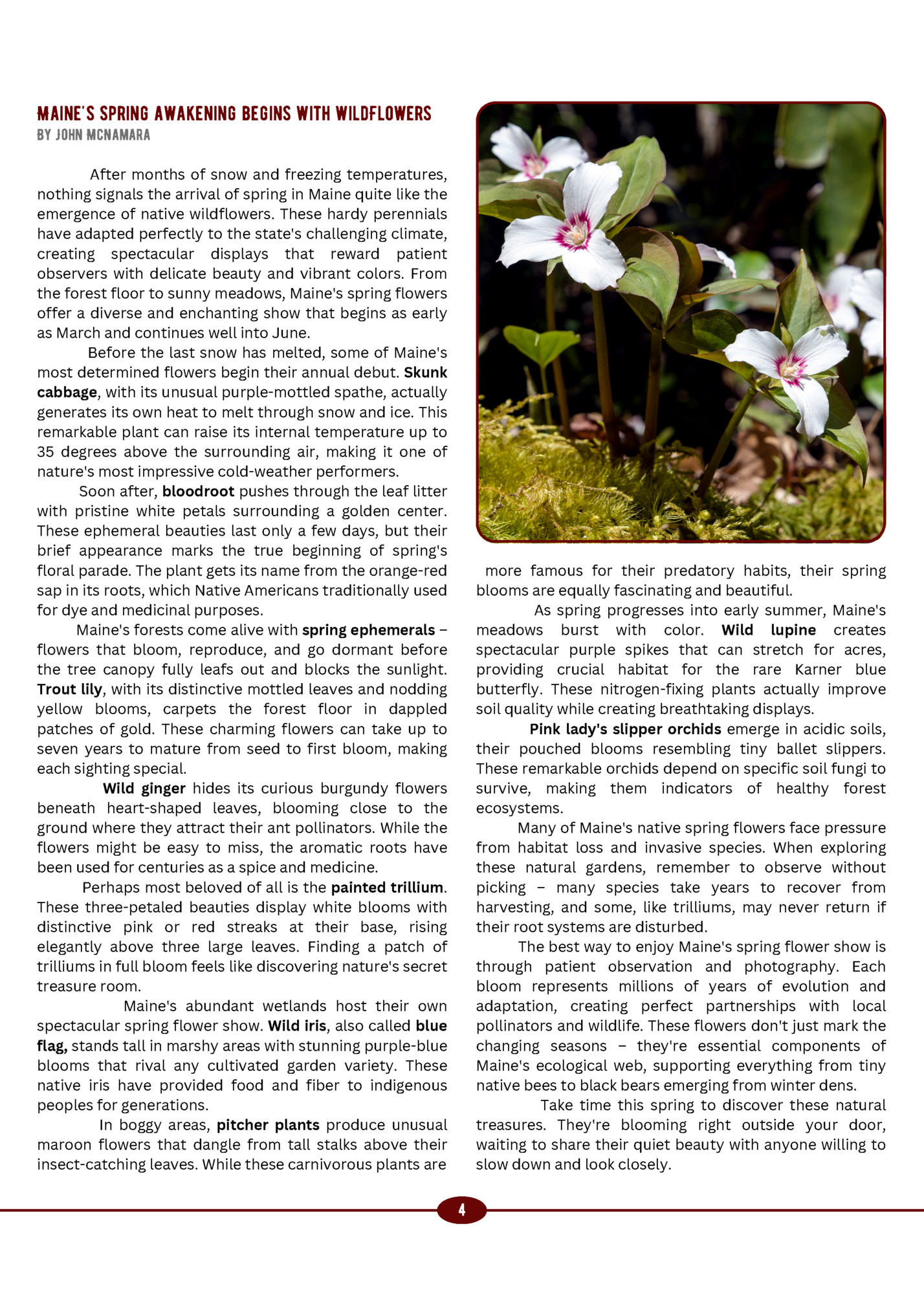
indicators of water quality because they have a wide range of pollution tolerances amongst various species, and hellgrammites represent the most pollution-sensitive category. The dobsonfly lifecycle is a testament to the complex connections between aquatic and terrestrial ecosystems. After spending years underwater, mature hellgrammites crawl onto land to pupate, usually burying themselves in muddy soil or decaying wood near stream banks. This transition from water to land makes them crucial connectors in the food web. By John McNamara In the pristine rivers and streams that flow through Maine's wilderness, few creatures are as impressive or as important as the dobsonfly. With their massive wings and intimidating mandibles, these ancient insects might look like something from a science fiction movie, but they're actually one of nature's most reliable indicators of healthy aquatic ecosystems. Finding dobsonflies in Maine's waterways is always good news – it means the water is clean and the ecosystem is thriving. The Eastern dobsonfly is Maine's only native dobsonfly species, and it's impossible to mistake for anything else. Adults can reach impressive sizes, with wingspans stretching up to five inches across their gauzy, brownish wings. Males are particularly striking, sporting enormous curved mandibles that can extend nearly an inch beyond their heads. These fearsome-looking jaws might appear dangerous, but they're actually too large and weak to inflict any real damage – they're primarily used for grasping females during mating rituals. Female dobsonflies have much smaller, more practical jaws that can deliver a sharp pinch if handled carelessly, but even they pose no real threat to humans. Adults are active at night and are attracted to lights, with an awkward fluttery flight but still travel considerable distances, occasionally showing up far from water sources. The dobsonfly's most important life stage happens underwater, where they spend two to three years as larvae known as hellgrammites. These flattened, segmented creatures are the true workhorses of the aquatic ecosystem. Growing up to three inches long, hellgrammites are fierce predators with powerful jaws that can deliver a memorable bite to unwary anglers who use them as bait. Dobsonfly larvae prey on aquatic insects, controlling their populations and maintaining stream health. They hunt caddisfly larvae, mayfly nymphs, midges, and other small aquatic invertebrates, helping maintain the delicate balance of stream ecosystems. Their presence indicates that the entire aquatic food web is functioning properly. What makes dobsonflies particularly valuable to Maine's environmental health is their extreme sensitivity to pollution. These organisms cannot tolerate any pollution in their waters and require sanitary water sources without contaminants. They typically occur only in high quality, well-oxygenated water, making them excellent bioindicators. They are actually indicators of clean water, and their presence is actively monitored by Maine's Department of Environmental Protection as part of biomonitoring programs. Benthic macroinvertebrates are useful Adults emerge in late spring and summer, living only long enough to mate and lay eggs – typically just a few days to a week. Adults live for a brief period and do not feed, focusing entirely on reproduction. Females deposit white, chalky egg masses on vegetation overhanging streams, ensuring that when the larvae hatch, they'll drop directly into suitable habitat. During their lifecycle, dobsonflies transition from aquatic larvae to terrestrial adults, and in doing so, bridge the gap between water and land. This makes them vital food sources for both aquatic predators like trout and bass, and terrestrial animals including birds, bats, and spiders. The next time you're exploring Maine's rivers and streams, remember that the presence of dobsonflies – whether as intimidating adults at streamside lights or as fierce hellgrammites under rocks – signals something precious: truly clean water. These ancient insects have been monitoring water quality for millions of years, long before humans developed sophisticated testing equipment. Their continued presence in Maine's waterways is both a testament to the state's environmental stewardship and a reminder of what we stand to lose if we don't protect these irreplaceable aquatic ecosystems. 5
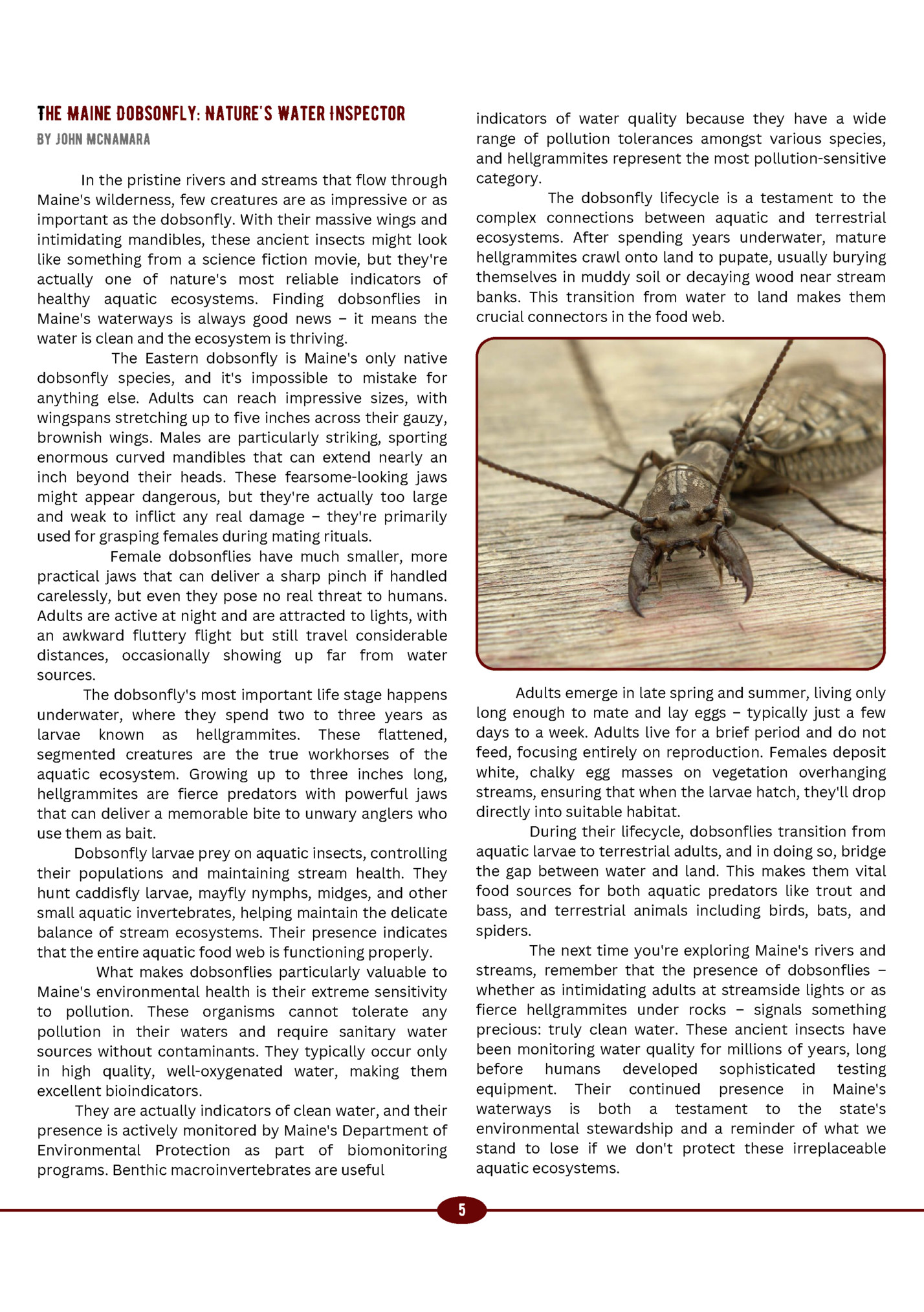
SUE GRIFFITH Good news! The Parkman Historical Society was recently offered a new home at the “Four Corners.” Our small collection housed at the Town Hall for the past ten years will finally have a new home, and a chance to grow. Other local societies have seen this pattern: once a collection is on display, more donations follow. Join us on Tuesday, 6/24 at 5p.m. at the Kimball place on Crow Hill Road to tour this historic farm house & barn. Ideas are welcome from all who have an interest in preserving the history of our small farm town. There are so many stories to tell, and artifacts to preserve! The Parkman family itself has quite a legacy, with three generations leaving their mark. While our namesake, Samuel Parkman, never travelled from his hometown of Boston to see the town that bears his name, he did dispatch Samuel Pingree to recruit settlers & sell farm lots. Parkman’s son travelled by stagecoach from Boston to Maine to collect on the mortgages here in town, and later Dr. George Parkman’s murder at the Harvard Medical School made international headlines. Samuel Parkman’s grandson, Francis Parkman became a famous author of history, and as a result, the annual Parkman Prize honors historic writings each year. In the early years Parkman prospered from farms raising sheep, but many of the early settlers moved on to bigger pastures. Charles Ellis left his farm on Harlow Pond to engineer the Golden Gate Bridge. Chet Chadbourne eventually left town to play a season with the Boston Red Sox. When residents voted down a proposed rail line at Pease Bridge, the rail line was diverted to Guilford and that sealed Parkman’s fate to remain primarily as a farming town. Around the same time that the railroad shifted towns, the farms shifted from sheep to dairy herds. By 1940 Victor McKusick left the business of milking Jerseys and went off to the war, and after the war he wrote a book that pioneered modern genetics. His twin brother Vincent went on to serve as the Chief Justice of the Maine State Supreme Court. Both of them may have envied their brother, Robert, who stayed in Parkman and ran the family farm. Logging, hunting & trapping supplemented what these small farms could earn, and many locals found work in the nearby mills. In more recent years, the back-toearth movement brought newcomers to town. Roxanne Quimby’s small business began at local craft fairs and became the Burt’s Bees brand, which Clorox purchased for the lip-smacking amount of $925,000,000. These are just some of the stories we hope to document and display. This process will take time and effort, so we welcome new members, and hope to build more of a community at the Four Corners. Early projects include a calendar of the oldest barns in town, heirloom gardens to honor the town’s farming tradition, and profiling the names that appear on the town’s Honor Roll. There’s a lot to be done, so we’ll see you there. 6

lisa mcnamara small. But, by early May, as late spring comes to life, everything POPS! Suddenly there are seedlings and sprouts everywhere—Squirrels hopping from tree to tree and deer spottings at every turn. We even saw a moose up close, which was super cool. It was sprouting its antlers and shedding its winter coat. Now as we head into summer, our yard is a lush green oasis, and flowers are popping up everywhere. A huge relief for me as I wrap up my first year of leaving Atlanta behind is that I still have relationships with the people that I feared I would lose—my Atlanta connections remain strong. My work lunch bunch still includes me on all the group texts and keeps me updated on all the wonderful and not so great things that are happening in their lives. My sidekick of silliness came to visit, and then we met up in NYC. But nothing makes me happier than our Jack, who has stayed connected with his circle of Atlanta friends who were like family. In fact, some are coming up this summer to see him. Maine-iversary This month marks my one year anniversary of living in Maine, and here is what I have learned, and experienced. Much to my surprise, Maine is HOT in the summer. Last summer the temperature reached well into the upper 90 degree (Fahrenheit) range more than I was prepared for, and that is hot when you live in a house without airconditioning. It’s also quite humid, which is something I had expected to leave behind in the southeast. I was equally surprised to learn that I love an ice cold shower after putzing in the garden all day, and sitting on the screened porch having dinner with my boys, and Peanut, until bedtime, leaving the tv and electronics turned off. Anyone who knows me well, knows I have a shameless love of trashy reality tv. This past year I learned that making friends in the fifth decade of my life is not as challenging as it was in my first, second, or third. Gone are the inhibitions of what people think—you know, the concerns of “being enough.” There is something about living in a small town that has freed me of trying to suppress my quirkiness, although some may argue I never really suppressed my quirkiness. It is very hard to hide anything in a tiny town, so people tend to be authentic, I love that. Everyone here is connected in some way, and everyone knows everything about everyone. Some may be turned off by that, but I find it quite fun and charming. Experiencing my first Maine winter was exciting, especially since I grew up in Mobile, Alabama. Until we moved to Maine I never experienced real snow—the kind that stays on the ground for six months. I had never driven on snow or ice before. I had not felt a wind chill so cold that it literally made breathing hard. Now, I have! And I loved it! Driving on snow is no big deal when roads are cleared and your car has “snow-mode” with all wheel drive. I am going to share this tip with my Atlanta friends, ASAP so they all come up and visit! I laughed when folks told me that the first time temperatures hit 50 in the “Spring” I would open the windows, and put on shorts and sandals, but I did just that! Spring in Maine is quite marvelous! Everything disappears in the winter months. The trees and bushes are reduced to brown sticks, and some plants disappear completely. Occasionally, you will see a miscellaneous black bird, but no squirrels—no other creatures, big or 7
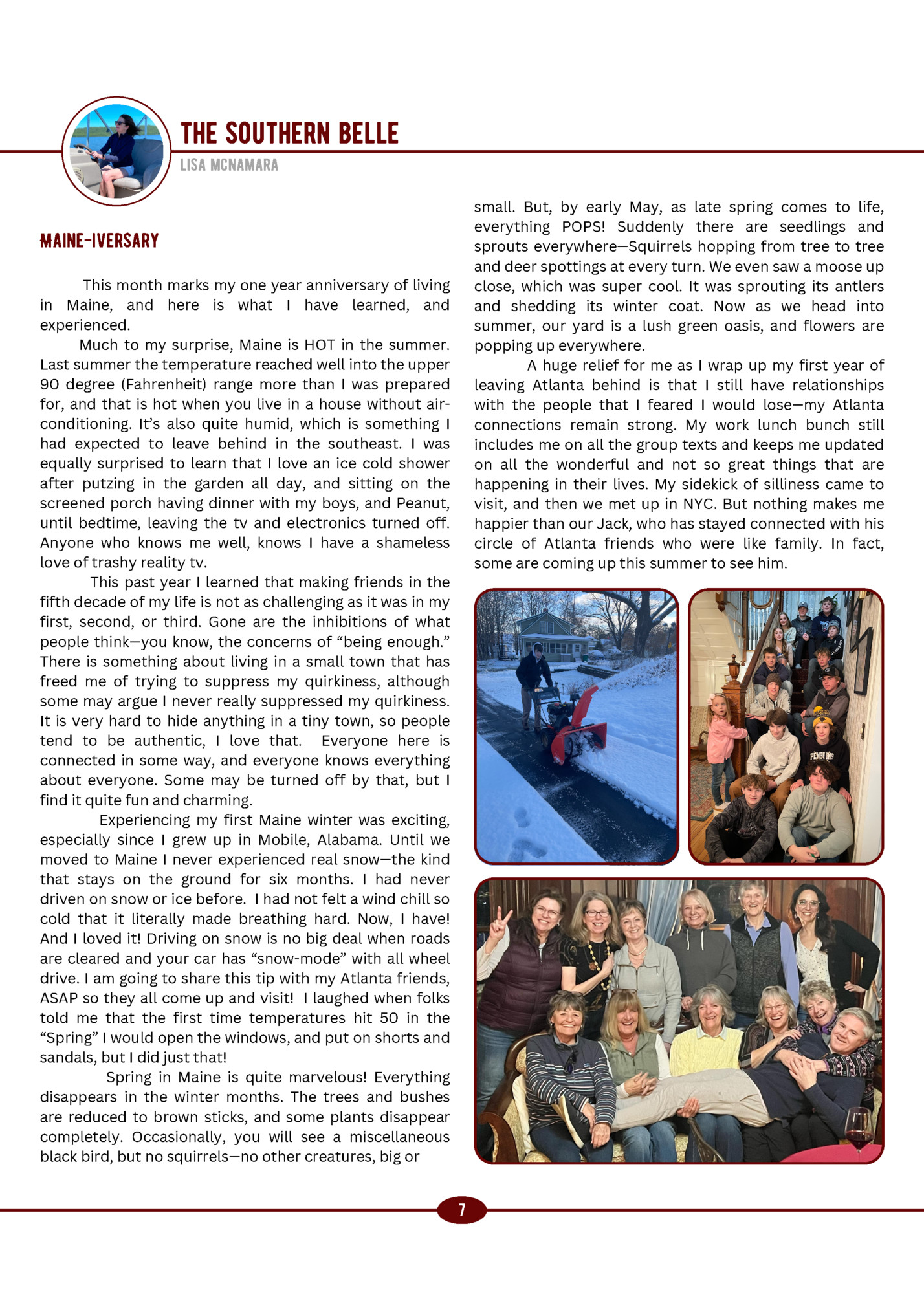
I love doing group exercise classes. Raspberries I pick daily in my backyard taste amazing. I like people that are different than me. Living without traffic jams and road rage is a beautiful thing! I can thrive in a rural town. My family can get by with a single car. Small towns have the same issues as big cities. Kid’s travel sports teams are fun for parents. (Especially when you have a fun parent group and a cool coach that encourages everyone hanging out between games). Watching my kid march in a parade is pretty special. Watching my kid thrive and grow in a new environment is priceless! Being able to see up close how smart, adaptable, curious, and accepting Jack is of new things and new people fills my heart with immeasurable joy. Guildford, Maine is just as fun as Atlanta, NYC, or London. For me, life is about people not places. God lives in Maine too. Every Episcopal Church REALLY does have the same liturgy and lectionary each Sunday. My family’s happiness is the most important thing to me. The biggest win of the year has been all the new friendships. The three of us continue to branch out and deepen our roots in our new town. Jack has created a community for himself of cool, kind, bright, clever, and some hockey loving kiddos. John has immersed himself and attends every Town Selectman, Historical Society, Chamber of Commerce, and Kiwanis meeting. I become a member of the Town Library Board of Trustees, and have befriended a marvelous group of women and men that have truly become “my peeps.” John and I are the Chairs of this year’s Piscataquis County River Festival expanding our circle even wider. Our move to Maine continues to be an education and an awakening. Here are a few additional things I have learned about myself: I really hate flying bugs! I am terrified of ticks, and talk about them abnormally. I really love nature! Our dachshund, Peanut, disappears quickly in snow and leaves. I enjoy waking up early. I love naps. PRESENTED BY THE 2025 PISCATAQUIS RIVER FESTIVAL JULY 26, 2025 7AM - 10PM Guilford, Maine This family-friendly annual event is a celebration of Guilford, Maine - the Chickadee and Lilac capital of Maine, and everyone who works so hard to make this quiet mill town a special place to call home. This year’s event will be bigger and better than ever showing how this town can come together for a weekend of fun, festivities and fireworks. The day begins with a 5K & Fun Run produced by Guilford’s own Community Fitness Center followed by a hearty breakfast at the Guilford United Methodist Church. After some exercise and full belly, everyone can enjoy a festive parade that runs through downtown Guilford, concluding at the Festival grounds where kids and adults can enjoy food and craft vendors, live music, a new kids zone (sponsored by Hardwood Products Co.) packed with pony rides, magicians, face painters, and balloon makers. We will have an obstacle course, a 3-point throw contest thanks to the Recovery Wellness Center of Sangerville, and a plethora of oversized yard games (corn hole, checkers, connect-four, etc.), and we bringing back the popular pie-eating contest (sponsored by Maine Highlands Federal Credit Union). We will have a duck race down the Piscataquis River, a Car Show, an expanded beer garden for adults, and all of the days activities will conclude with a dazzling fireworks display in the beautiful Guilford summer sky. And new this year, we will have live music all day on the A.E. Robinson Music Stage, starting with My Want My MTV Retro Band, Brian Smith, Josiah Dyer, The Josh Guthrie Band, and Julia Gagnon (of American Idol fame). Come one, come all to celebrate Guilford, to celebrate Maine life, and to celebrate friendships! For more information, schedules, or to get involved, visit: www.piscataquisriverfestival.org 8

edited by margie e. burke ACROSS 1 It may be slipped 5 Island greeting 10 Everett or Lowe 14 Hang ____ (keep) 15 Constrain 16 Latvia’s capital 17 “It’s ____ real!” 18 Like some milk 20 Fellow church-goers 22 Aristocratic bunch 23 “Baby Blue” singer George 24 Out-of-date 25 Loads software 28 Reuben’s bread 31 Mere 34 Annulment of slavery 36 Away form the wind 37 Like Liberace 38 No walk in the park 39 Written account 41 Beds on base 42 Angsty music genre 43 Skilled boater 45 Puppeteer Lewis 47 Does an IRS job 51 Tariff target 53 CDC worry 55 Like some garden paths 57 Word after “cut” or “second” 58 Walk the floor 59 Verso’s opposite 60 Alaska’s first governor 61 Downhill racer 62 Web destinations 63 Bodywork target DOWN 1 Former newsman Lou 2 Type of gas 3 Animal in a roundup 4 Tupperware product 5 Gives a heads-up 6 As it happens 7 Middle East gulf 8 Cheer starter 9 Without much harmony 10 Shire dinner entree 11 Nazi-like 12 “The Morning Watch” writer James 13 A&W competitor 19 Mantegna’s “Criminal Minds role 21 Touch 24 One who works on snow days 9 26 South Pacific island 27 Overheard 29 Famed WWI sergeant 30 Concludes 31 All there 32 Happy as a ____ 33 Lockheed Martin field 35 Roared deeply 37 First-string players 40 Oscar or Tony 41 Modern measure 44 Tropical fruits 46 Sharpened 48 Mirror ____ 49 Nashville NFLer 50 Candle feature 51 Little devils 52 Dinner, eg. 53 Ancient Celt 54 Feed the kitty 56 Outdoor gear band

Fleepit Digital © 2021